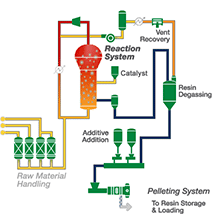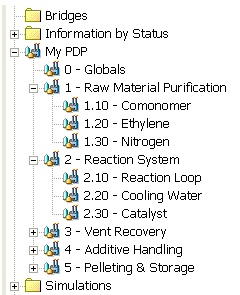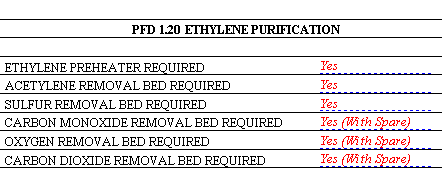Key Benefits
- Exceptional productivity gains
- IPPD proprietary knowledge to update PFDs automatically
- Data Integrity and consistency from front end to detail
- Auto generation of utilities consumption and lists
- Linked to calculation programs and third party applications
- IPPD utilities for export to downstream tools
Automated Process Design Package
This area of technology is most likely to suit Licensors and Owner Operators who license and/or own established technologies and strive for optimum efficiencies and incremental improvements in their processes.
When IPPD was introduced to this specific customer, the chosen front end engineering design and detailed downstream vendor applications had already been selected.
Our brief from the customer was simple...automate the Process Design Package (PDP) to our work processes and then tell us what you did. The different solutions applied to this project pushed some of the boundaries of the tool sets configured.
This particular implementation looks at some of the problems and challenges faced with automating an entire PDP to ultimately produce the same end deliverables used by the legacy system.
Background
This customer incorporated relevant company standards in order to enforce and maintain company best practices in data usage and the production of "fit for purpose" deliverables. In the past, managing paper based deliverables has meant that the process of updating and maintaining deliverables always slipped through the net. It was seen as too much effort for very little direct gain and leads to difficulties later in finding up to date information.
This customers legacy work processes and practices involved many facets of automation to produce these paper based deliverables. These included office tools, bespoke custom applications, third party vendor tools, and manual transcribing of data from one source to another to name just a few. Layered on top of these tools were isolated snippets of engineering knowledge captured in individual calculation sheets, documentation and other resources not always available to other engineers.
IPPD was introduced to realize and implement an approach to managing process plant data and knowledge, and facilitate effective work flow throughout the engineering life cycle using the Aspen Basic Engineering product suite.

Analysis
The analysis process is a crucial part of understanding the legacy work processes and procedures. It pieces together the individual components of the process to give clarity on how the current system operates and the end deliverables to be produced.
IPPD looked at all aspects of this customerís system to ascertain and understand the requirements for overhauling and re-implementing the system using Aspen Basic Engineering.
More importantly, the customer also played an important role in the analysis process and also reviewed their internal procedures and practices to overhaul and improve their work processes. This involved, in the main, standardisation of artefacts that were used as part of the design process, but also the removal of redundancies, and quality improvements in the remaining tool sets.
Feasibility
With any new implementation, one has to consider the requirements of the system and the capabilities of the software tools to ensure a solution is delivered that is feasible and fulfils the expectation of the customer.
For example, this customer did not want to use Excel and wanted to incorporate all of the calculation knowledge routines in the front end tool. However, by doing this, arguably, they were losing some of the quality documentation that was available which could not be reproduced in the rule language.
Although we could store this documentation as a file in Aspen Basic Engineering and access it during equipment sizing, it did not seem to be the most efficient process. As a compromise, in this case, the basis of design data for equipment sizing was bridged with the Excel sheet. This process of compromise was applied to every aspect of the design package to ensure the project workflow was streamlined, completed on time and on budget.
Implementation
Making sense of the vast information acquired through the analysis and feasibility phases is challenging but has to be delivered as an intuitive engineering system for end users.
IPPD wanted to give a lot more engineering functionality than the derived requirements in the analysis and feasibility phases. It was important for IPPD to provide a scalable framework that allowed the customer to easily build extensions without the need for on-going expert support.

Solution
The automated solution is a configuration package comprising of components layered on top, or replacing the out of the box library components for Aspen Basic Engineering. Every aspect of the library components was configured and included complete replacement of the datasheet, symbol, label and rule library components.
In addition to the library components, IPPD also created a bench marked Process Design Package (workspace) as a starting point for all projects. This was the customerís evergreen project template.
The template contains pertinent project data and includes semi-populated datasheets, semi-completed and completed PFD's, Bridges ready for equipment sizing, rules for determining inputs for equipment sizing and a Plant Breakdown Structure representing the design with automatic equipment and document filing capabilities, and linked equipment naming conventions etc.
The automation was built on the premise of limited or no data entry by engineers. This was to minimize engineers introducing errors and to maintain integrity of the design.
Simulation data flow - IPPD decided to move away from the conventional method of transferring simulation data to the PFD objects, this is typically done by the Aspen Basic Engineering ObjectMapper interface. Instead we opted to control this process through rules. IPPD was able to replicate the "under hood" interface and maintain data flow and mappings as if the interface had been used.
Equipment sizing - Determining the inputs (best case) for equipment design was performed by one of the many rules delivered in the system all with reporting features so as to instruct the engineer of the results and next steps. All in-house sizing programs are controlled by Bridges and a framework was built that enforced controlled standards and procedures to size equipment.

Automatic Heat & Mass Balance - As IPPD have an in-depth knowledge of the entire system, we provided the ability to automatically generate heat & mass balance grids for the main process lines via rules and populate them with the governing case for the PFD process.
Proprietary Graphics - One of the major highlights of this project was automatic manipulation of PFD graphics through the use of rules. To assist the engineer with the many permutations that could result from a prospective client, IPPD provided a proprietary, innovative and intuitive piece of technology to solve the graphics problem.
Engineers no longer needed to draft the configuration chosen by the client, instead they simply selected from a datasheet the configuration required and the system would automatically configure the PFD (auto routing the connection lines where necessary), update lists, and remove unwanted pieces of equipment and their respective datasheets.
Utilities - IPPD provided a framework to capture the utility consumptions for the individual equipment items. With the use of rules these consumptions were utilised to auto generate utilities list.
Other - There are many areas of the Aspen Basic Engineering suite in which IPPD are pushing the boundaries of automation to provide pioneering solutions for our customers. Unfortunately we are unable to report on all of the technology areas, but hopefully we have demonstrated some of the capabilities that IPPD can offer through Aspen Basic Engineering configuration to give our customers the competitive edge.
